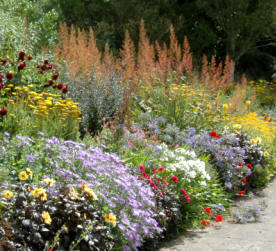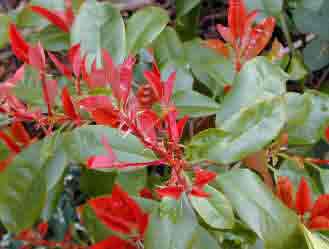Planning and making a Herbaceous Perennial Border or Bed.
You will probably already have an idea of where you want your herbaceous border or bed to be in your garden. A light sunny aspect is best, but dappled shaded areas can also be used with the choice of the right herbaceous plants.
Herbaceous beds and borders tend to be better in informal shapes rather than straight lines. This is mainly because of the wide range of shapes, sizes and flowering periods of perennial plants are more suited to informal shapes rather than formal shapes.
However, if your garden is already laid out in formal shapes, and you prefer rectangles to kidney shape beds – or straight border edges rather than curved edges, no problem – go for what you want! Just bear in mind that the perennial plants within the beds will take on an informal appearance.
The Plan!
 Mixed Herbaceous Perennial Border at Great Comp
Garden in Kent - UK
Mixed Herbaceous Perennial Border at Great Comp
Garden in Kent - UK
General advice on planning and making a
herbaceous border, usually advises the use of a bit of graph paper and
pencil. Forget that unless you have a very good knowledge of herbaceous
perennial plants, and you can also visualize what your border will be
like from a two dimensional sheet of paper.
By far the best way is to get out in your
garden with a few canes of different lengths to coincide with the height
of the perennial plants you have bought, or are going to buy. Now, with
the help of your canes, you can create a three-dimensional ‘plan’ taking
into account the surrounding trees, shrubs, fences and other aspects of
the garden that will have a visual impact upon your herbaceous perennial
plot to be. It is essential to get this right before you start making
your perennial border
Place your canes in the places best suited
for the height of your plants, and you will soon start experimenting on
what to put where. It is surprising how different this will end up,
compared with an inanimate sheet of graph paper. At the same time – if
you have not already done so, you can ‘lay out’ the edge shape with the
use of a hose, and adjust shape to suit from all angles. This is one of
the best ways of making curves
in the garden.
Bear in mind that herbaceous perennial
plants will be in the same position for a long time – maybe years – so
prepare the soil well. Add rotted manure, peat or compost as you dig.
Dig down a good spade or fork depth, and then tread the dug over soil
firm. Not when sodden wet! Remove every bit of weed growth you can find.
Weeds are a pain in the neck in herbaceous areas.
Choice of Herbaceous Perennial Plants
Herbaceous plants can be used for more or less any position in the garden. The choice of herbaceous perennials has never been greater, with new varieties coming onto the garden centre shelves each year. Together with that, it is now possible to buy perennials in flowering-size pots, so you can be absolutely sure of what you are buying.
If you are planning on designing a herbaceous bed or border, you have two basic choices. You can either trawl through catalogues and web sites trying to find the plants that will suit your plan, or you can go out on a few plant-hunting safaris and buy what you like the look of, and fit that into your proposed bed or herbaceous border.
The second option might seem a bit hit and miss, but there are thousands of herbaceous perennials out there to choose from and a visit to a handful of garden centres or nurseries will probably furnish you with a few gems that would have been overlooked by going down the "plan it and then find it route"!
Perennials are normally well colour-labelled for in the early spring. There will be little other than the label that will be there to see!
Don't try to buy all your plants in one visit. Take your time. Spread your visits over a few weeks and you will find different herbaceous plants each time.
DO take note of the label, regarding ultimate size! A plant in a small 3.5in - 9cm sq pot can reach a height of a metre or so and a spread of 2ft (60cms) in the first season depending upon variety. The second year it can double in size yet again!
Refer to our suggestion of placing canes in your plot to correspond with the eventual size, and mark out on the ground (a sand trail is ideal) the anticipated spread. Above all remember that herbaceous perennial plants don't always do what they are supposed to do in regards size!
A group of Trilliums - 1 metre across -
that started life as one small plant in a
single subject herbaceous bed!
Best Selling Gardening Products
Popular Gardening Sections

Problems
Identify Weeds in The Garden - How to deal with weeds. Diseases and Pest which harm your garden and plants, learn how to prevent, deter and erradicate your garden problems.
Garden Problems
Pruning
Pruning Guide. Shrubs flower better with correct pruning. Many illustrations and examples of what to do - and when. Includes evergreens, roses, flowering shrubs, spring flowering shrubs and pruning for stem effect. This is our most viewed and comprehensive section,
Pruning
Gardening Businesses
Gardening Businesses listed in the UK counties and USA states. County and State Listings of businesses involved in Garden supplies and services. If you wish to be added to the Directory, please send us your information. Having problems, use the search box
Businesses
Gardening
In this section you will learn about Gardening Basics, Containers, Landscaping, Propagation and Soil.
Gardening
Gardening Gifts
Gardening Gifts and Reviews, Read Before you Buy
- Gardening Gifts Ideas
- Gifts For Her
- Gifts For Men
- Power Tool Gifts
- Cheap Gifts
- Personalised Gifts
- Wildlife Gifts
- Family Gifts



